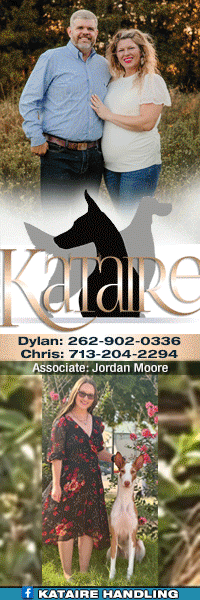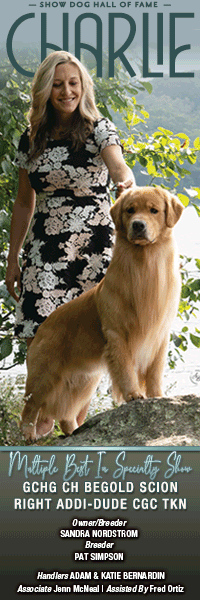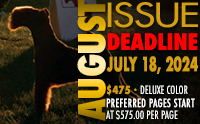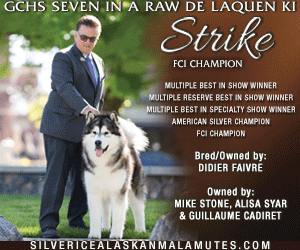A Different Look – The Modified Continental Trim for the Show Ring!
Click here to read the complete article
266 – September 2019
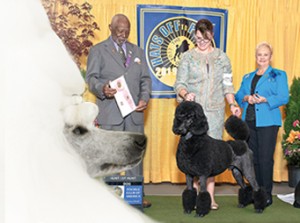 By Joyce Carelli &?Jaci Bowman
By Joyce Carelli &?Jaci Bowman
The Modified Continental (ModCon) – the trim is also known as the Historically Correct Continental, Hunting Class Clip, Heritage trim, and the HCC.
This trim has ALWAYS been accepted in the AKC breed standard for Poodles as long as the trim presents a smooth unbroken outline on the dog. The breed standard for Poodles does not mention how long the coat on the dog must be, just some modifying phrases such as “ear fringe should not be of excessive length.” Shaping of the coat to ensure balance is permissible in all trims per the standard.
This shorter variation of the continental trim is ideal for owners wishing to compete in performance/companion dog events while at the same time show their dog in conformation events.
For performance/companion dog events, a long coat is a safety and a training issue. Dogs running in many dog sports events are at physical risk when competing with long banded ears and topknots. More than one poodle running with banded ears, topknot and/or neck hair has had issues with the bands getting wrapped around or stuck in equipment such as jump supports, coursing wires or thick brush. Maintaining coat while training field and tracking work has always been a challenge and can also be dangerous for the dogs.
With the recent acceptance into the AKC Spaniel Hunt Test program, the Modified Continental trim has become even more important, as dogs running in that event may not wear bands in their coats or ears, per AKC.
The Modified Continental (ModCon) trim is pictured in the new Poodle Club of America’s Illustrated Breed Standard 2018 (available through the Poodle Club Of America online store). The word is out! Judges, owners and handlers alike should now know the trim is legitimate, and also, more importantly, what to expect it to look like.
The Modified trim is far from the easy way out to show a poodle. The shortness of the coat means less day to day maintenance such as brushing, bathing, and drying. This makes it less time consuming for the owner and dog between shows. It also means less table time for the dog at the shows as well, as it does not require spraying up in prep for showing or breaking down time after being shown.
However (and this is the important part), the trim requires an exceptional eye for balance, and superior trimming skills. It generally needs to be trimmed every few weeks to stay in tailored show shape and ready for final prep. It is NOT just a full coat with a scissored topknot. It is a balanced, tailored trim that can go from the field to companion events to the show ring and back again while maintaining the elegance and dignity peculiar to a Poodle. Mistakes in trimming are usually less forgiving in this shorter trim and–as with other short trims–you can make more mistakes much faster with less coat!
One of the beauties of the trim is that in a few months’ time you can go from a kennel short trim to show trim and be ring ready if you wish. Or just keep the dog in the short trim, as it also works well in the whelping box!
Plus, the dog always looks good, not just the 10 minutes in the breed ring in all the full coated glory of the banded spray-up. Spray is definitely not needed, nor are extra hairpieces, making the dog a legitimately AKC legal exhibit! Also, It is a ‘touchable’ trim at shows. No need to worry about someone inadvertently petting the dog right before heading into the conformation ring!
We will be discussing the Modified Continental trim here. However, the differences in a shorter trim may also be applied to the English Saddle and the Puppy trim. The main thing to take into consideration is the fact that in ALL of these trims a “smooth unbroken line” is imperative. This includes the front jacket, neck and head area blending into the topknot.
In all trims the Poodle is to present the appearance of a‘very active, intelligent and elegant-appearing, squarely built, well-proportioned dog, moving soundly and carrying himself proudly.’ So balance and proportion in trimming is of particular importance.
One of the challenges of this shorter trim is how to keep the dog looking square as called for in the breed standard. In full coat you have a lot of coat to work with. A good groomer can take a longer than square dog and trick the observer’s eye by trimming it so that this exhibit actually appears square. Some of the tricks are by adding height to the topknot and tightening up the front of the jacket as well as shifting the jacket line back towards the tail, shifting the rosettes back towards the tail, leaving them full and rounded and growing more neck coat to balance out and fill in the ruff. This causes the focus of the trim up and a tad back, making the dog appear more squarely built than it is in actuality. The observer’s eye will usually go to where the pattern changes from big round jacket and topknot to the rosettes, and the center of the dog appears to actually be moved.
If you set the pattern the same way for the Modified Continental (or shorter Puppy or English Saddle trims), even a squarely built dog will look long-bodied!
In the short trim, you need to pull the eye of the observer forward. You do not have a lot of height to work as the topknot is scissored and not normally banded so the observer’s eye will naturally go to the jacket body. If the jacket body is set back towards the tail, with the rosettes set close to the tail set, the observer’s eye will look in that direction. HOWEVER, if the jacket is brought up close to the last rib and the rosettes are also moved forward, the observer’s eye will naturally go to the break in pattern line. The center of the dog and the dog will again have moved and will then have the appearance of a shorter-bodied animal.
Adding to the balance issue is the length of the neck coat (some like to call it the roach) that travels down the back of the dog’s skull along the topline of the dog’s neck, over the withers, and onto the back of the jacket. If that is blended well into the jacket, you will again bring the dog together with a smooth appearance and shorten the body of the dog.
Also remember that all parts of the trim must be in balance. Rosettes (which are and always have been optional) should be in balance with the rest of the trim. If the rosettes are left large and taller than the jacket, they will give the appearance of the dog being high in the rear.
In the Modified Continental it is proper to have the rosettes a touch flatter and a bit oval in appearance which can help the effect of shortening the dogs body.
The bracelets on all legs also need to be balanced with the trim and can be set a touch lower to give the dog a longer legged appearance. Save the big round bracelets for the full coats, as those are needed there to balance the very full jackets and topknots. Otherwise full coated dogs would look like they are walking on toothpicks!
The tail pom also needs to be in balance, but that balance is with the TOPKNOT…so, if your dog is carrying a nice full trimmed topknot, the tail should be in pleasing balance to that, not a tiny Q-tip tail!
One other thing to note — you do need neck coat fill over the withers so the dog doesn’t have an “L” shaped appearance over the withers to the back of the jacket. It takes away from the smoothness of the pattern lines, and generally is not a pleasing picture.
The front of the neck on both sides under the ear drop should also be tightly trimmed, otherwise the dog appears short necked which is another common mistake in a shorter trim.
The neck should gradually blend back into the shoulder, and the shoulder smoothly into the rest of the jacket.
…And then there is the topknot!
The headpiece is a very tricky part of this trim. It must present a smooth flowing line into the neck and jacket coat. There must be NO separation line between the topknot coat and the ear feathering even if the dog has one or more bands in the hair. To balance the rest of the trim, the ear feathering must be shortened.
One of the easiest things to picture is the ear and the head making up a single unit. The top of the ear is blended into the side of the topknot and blended down into the feathering of the ear.
The most pleasing balance of length of ear feathering is just even with the end of the muzzle or just slightly longer. That way a dog with a longer muzzle will carry more length to balance out the length of the foreface. If the ears are considerably longer, it tends to shorten the dog’s neck appearance and look out of place on the very tailored modified trim.
The topknot needs to carry some height, but excessive height also looks out of place on this trim. In addition, you must also remember that the undercoat is what supports the topknot of this trim and if you leave the topknot TOO long the undercoat cannot support it. The topknot then turns into a ‘flopknot’ and is very unattractive.
The easiest way to achieve a nice topknot is to layer the coat from the outside in towards the head, blending with a blenders/chunkers is a quick way to accomplish it smoothly (blenders or chunkers are a very widely spaced, single-edged, thinning-type shears).
You also have to look at the face and headpiece under the hair, as that will also give you a clue about what shape the topknot should carry.
If you have a heavier head, as the old rule of thumb goes, you want to FRAME the face…in other words, the ear feather is left fuller, no longer but more ‘fluffed out’, towards the side of the head.
With a leaner head, as the old rule goes, you SHOW the face, by tightening the topknot and ears toward the muzzle/skull. In doing so you give the dog a leaner, more dramatic expression by accentuating the refinement in the face. If you were to do that on a heavier headed dog, it would make the dog look much worse and coarse.
You also want to remember the ‘bubble’ which is usually always present on a banded topknot. You can achieve a similar look by leaving a slight overhang over the eyes that is carefully trimmed and rounded back into the topknot. It helps gives the Poodle the intelligent expression we all so dearly love.
This pretty much sums up the differences between the full-coated Continental trim, and the Modified Continental trim. There are advantages to both trims–and remember that all dogs cannot wear all trims.
With the upsurge of interest in performance sports and the ever-changing demands in society, the Modified Continental is being seen in the conformation ring more often, and when it is on the right dog and trimmed properly, it is a very pretty, classy trim for our very versatile breed of dog! As testament to this, there were at least 10 Standard Poodle specials shown by handlers and owners that were in Modified Continental trim at the recent Poodle Club of America national specialty in April. At least a few carrying this trim were placed in the classes of all varieties. There have been two local specialty winners–to date–in the trim (one Miniature and one Standard) as well as numerous BOV and group placements given by well-known and respected poodle judges. The trim presents a particularly attractive alternative to both handlers and owners alike for the various reasons stated above and, in addition, it gives some previously retired dogs an excellent way to continue competing at the highest level. The future of our breed definitely includes this elegant but shortened version of the traditional full continental so you should be watching for it in a ring near you!
Click here to read the complete article
266 – September 2019
Short URL: https://caninechronicle.com/?p=172473
Comments are closed




